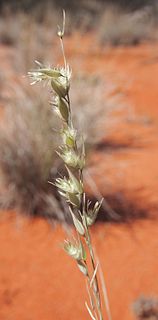
Saccharum is a genus of tall perennial plants of the broomsedge tribe within the grass family.

The Cyperaceae are a family of graminoid (grass-like), monocotyledonous flowering plants known as sedges. The family is large, with some 5,500 known species described in about 90 genera, the largest being the "true sedges" genus Carex with over 2,000 species.

Stipa is a genus of around 300 large perennial hermaphroditic grasses collectively known as feather grass, needle grass, and spear grass. They are placed in the subfamily Pooideae and the tribe Stipeae, which also contains many species formerly assigned to Stipa, which have since been reclassified into new genera.

Ehrharta is a genus of plants in the grass family.

Moritz Kurt Dinter was a German botanist and explorer in South West Africa.

Polypogon is a nearly cosmopolitan genus of plants in the grass family, commonly known beard grass or rabbitsfoot grass.

Caesia is a genus of herbs in the family Asphodelaceae, subfamily Hemerocallidoideae, native to Australia, New Guinea, Madagascar and Southern Africa. The mostly 3-lobed seed capsules contain rounded black seeds. The genus was named in honour of Federico Cesi (1585-1630), an Italian scientist.

Hans Schinz was a Swiss explorer and botanist who was a native of Zürich.

Perotis is a genus of Asian, African, and Australian plants in the grass family.

Coelorachis is a genus of plants in the grass family, widespread across much of Asia, Africa, Australia and the Americas.

Coleanthus is a genus of Eurasian and North American plants in the grass family. The only known species is Coleanthus subtilis. It has a scattered distribution, found on lakeshores, streambanks, and other wet places in central Europe, Asia, and northwestern North America.

Triraphis is a genus of African, Arabian, Australian, and Brazilian plants in the grass family. Needlegrass is a common name for plants in this genus.
Entoplocamia is a genus of African plants in the grass family. The only known species is Entoplocamia aristulata, native to Angola and Namibia.

Monachather, common name mulga oats, is a genus of Australian plants in the grass family.
Rhytachne is a genus of plants in the grass family. They grow principally in wet savannahs in Africa and the Americas. More specifically, they tend to prefer transitional zones between marshes and drier upland savannahs. In the Americas the genus can be found from southern Mexico and Cuba south to northern Argentina, while in Africa it is present below the Sahara, including in Madagascar. Twelve species are included, of which nine are African, two are American, and one, Rhytachne subgibbosa, is found on both continents. The genus is closely related to Coelorachis.

Bolboschoenus is a genus of plants in the sedge family, of nearly cosmopolitan distribution. Epipaleolithic and Neolithic peoples used ground root tubers of these plants to make the first breads.

Leopold Trattinnick was an Austrian botanist and mycologist. He was a curator of the Royal Natural History collection in Vienna. He published several mycological and other botanical works. Most of these works were illustrated with engravings and many of them were hand coloured. He also gave out collections of wax replicas of species of fungi and later sponges.
Stipagrostis hirtigluma is a densely tufted perennial grass. It occurs across most of Africa east to Pakistan in bushveld, karoo, and desert regions. In Namibia, it grows in dry, warm parts, in stony or sandy places and on rocky outcrops.

Rhodocoma capensis, called the Cape restio, is a species of reed-like perennial grass in the family Restionaceae, native to the southwestern Cape Provinces of South Africa. Growing over 2 m tall, with clumping, jointed stems, it has gained the Royal Horticultural Society's Award of Garden Merit as an ornamental, suitable for borders and architectural applications.
Lefebvrea is a genus of flowering plants belonging to the family Apiaceae.
















